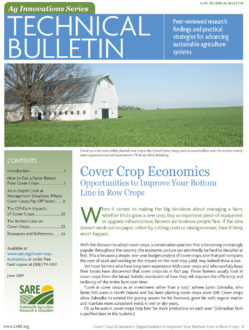When evaluating average fields in average weather conditions, it can take three or more years for cover crops to pay off if no incentive payments are obtained and no special circumstances exist. However, every farmer has their own challenges and opportunities that can affect this picture. Therefore, when evaluating the economics of cover crops, it can be helpful to consider common situations or scenarios under which they will pay for themselves more quickly, often within a year or two. Seven situations in which cover crop profits are accelerated are listed here and then described in more detail in a later section of this bulletin.
Cover crops can pay their way more quickly when:
- Herbicide-resistant weeds are a problem
- Cover crops are grazed
- Soil compaction is an issue
- Cover crops are used to speed up and ease the transition to no-till
- Soil moisture is at a deficit or irrigation is needed
- Fertilizer costs are high or manure nutrients need to be sequestered
- Incentive payments are received for using cover crops
Many farmers may experience more than one of these situations. Cover crops will quickly pay off when two or more of these situations occur together. The farmers profiled in this bulletin reflect this view that cover crops are most profitable when they provide benefits in multiple areas.
For example, Tennessee farmer Ray Sneed plants a five-species cover crop mix with multiple goals in mind. “Each species has a job, and those jobs are based on where I have problems,” says Sneed, who farms 10,000 acres of corn, soybeans, wheat and cotton.
His mix includes tillage radishes, crimson clover, wheat, cereal rye and turnips. Their primary jobs are to scavenge nutrients, alleviate compaction, improve water infiltration and suppress weeds. After six years of cover cropping, Sneed is saving money by using less irrigation water, fertilizer and herbicide. “We’re learning that we can use some of these species to offset the costs of growing our crops,” he says.
Before getting into the detailed economics of these seven situations, the first step in this bulletin is to summarize some baseline data on cover crop yield impacts and to outline assumptions on cover crop costs and returns. These numbers will provide a baseline for the seven specific situations in which cover crops can provide a reasonably fast economic return.
